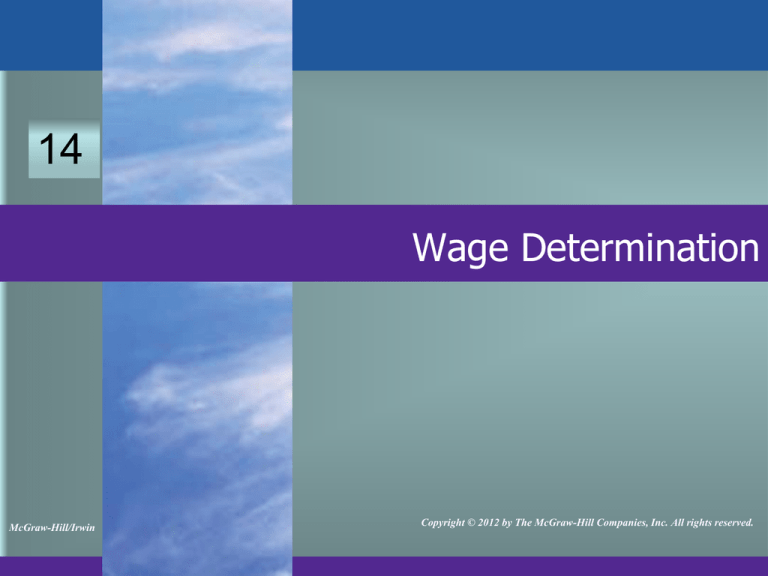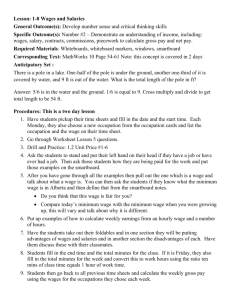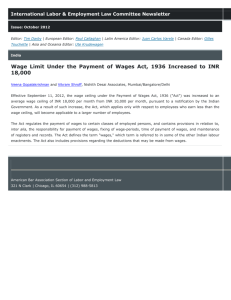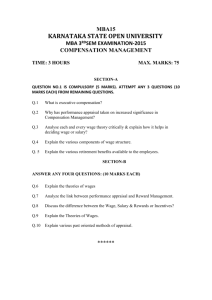
14
13
Wage Determination
McGraw-Hill/Irwin
Copyright © 2012 by The McGraw-Hill Companies, Inc. All rights reserved.
Goals
Differentiate between nominal and real
wages.
List those factors that have led to an
increasing level of real wages in the U.S.
historically.
Non necessarily in the last four years
Determine the equilibrium wage rate
employment level
• when given appropriate data for a firm operating in a
purely competitive
Chapter Goals
Illustrate graphically how wage rates are
determined in
purely competitive
monopolistic labor markets.
List the methods used by labor organizations
to increase wages
and the impact each has on employment.
Chapter goals
Illustrate graphically how an inclusive
(industrial) union and an exclusive (craft)
union would affect
wages and employment in a previously
competitive labor market.
Explain and illustrate graphically wage
determination
In the bilateral monopoly model.
Present the major points in the cases for and
against the minimum wage.
Chapter Goals
Explain the demand factors that create wage
differentials.
Explain the supply factors that create wage
differentials.
Describe briefly salary systems in which pay
is linked to performance rather than to time.
Describe the negative side effects of poorly
planned incentive pay plans.
Define and identify terms and concepts
listed at the end of the chapter.
Income
The money a person receives in exchange
for work or use of property
Many sources
Assets
Work done
• Labor wages make up 70% of all total income
• 30% from interest, dividends, rents profits
Answer
So what will you be making 6 years after HS
per year?
Name some high paying careers?
What education level does each require?
Answer
What do you think ---?
Half sheet of paper
Name
Highest level of education attained within 6
years after HS.
Anticipated 1 year earnings
What will justify you being paid that amount?
Elements To Higher Wages
Education
The “right” education
Skills
Hard work
Supply and demand for a particular position
None of these are a guarantee for high wages
Labor, Wages ,and Earnings
Wages
Price paid for labor
Direct pay plus fringe benefits
Wage rate
Price per unit paid
Labor, Wages ,and Earnings
Nominal wage
Amount of money received per hour
Real wage
Quantity of goods or services a worker can
purchase
With a nominal wage
Wages
Real wages only increase if nominal wages
increase faster than the inflation rate.
If prices increase faster than nominal wages,
real wages will fall.
Over the last 5 years, real wages for the
lowest 70% of educated in US
Wages And Employment
For most, labor market is only source of
income
We work and earn a wage
But: What determines the amount of labor we
supply?
What determines the amount of wages will be
paid?
Role Of Productivity
Demand for labor (or any resource) depends
on productivity
Generally
The greater the productivity of labor
The greater the demand for labor
Role Of Productivity
Demand for labor in advanced economies is
large
Because labor is highly productive
GDP
The market value of all officially recognized
final goods and services produced
within a country
in a given period of time.
GDP per capita is often considered an
indicator of a country's standard of living
GDP per capita is not a measure of personal
income
Under economic theory,
GDP per capita exactly equals the gross
domestic income per capita
Role Of Productivity
Plentiful capital
Access to abundant natural resources
Advanced technology
Labor quality
Other factors
Role Of Productivity
Plentiful capital
Physical
Money
Access to natural resources
Available in large quantities
In relation to labor force
Advanced technology
Available capital is also advanced
Role Of Productivity
Labor quality
Healthy
Vigorous (motivated)
Educated
High quality training
Therefore, tend to be efficient
Other factors
Efficiency of management
Business, social and political environment
Increased specialization
Real Wages and Productivity
Generally a close relationship
Real income and real output are two ways of
looking at the same thing
Per worker compensation can only increase
At about same rate as productivity or output per
worker
Real Wages and Productivity
Real world, suppliers of land, capital and
talent also share in profits (today;
disproportional)
Therefore, real wages do not always rise the
same as productivity
Over short periods of time
Over long term, productivity and real wages
tend to rise together
Book page 273 figure 14.1
Output is increasing
Compensation not keeping pace
WHY?
Research: Start with Huffington Report
• Wages aren’t keeping up with US Productivity
Real Wages and Productivity
Ford Motor Company made headlines in 1914 by offering autoworkers $5 per day, up from $2.50
day. The wage payment was newsworthy because the typical market wage in manufacturing at
time was just $2 to $3 per day.
What was Ford’s rationale for offering a higher-than-competitive wage? Statistics indicate that the
firm was suffering from high rates of job quitting and absenteeism. It reasoned that a high wage rate
would increase worker productivity by increasing morale and reducing employment turnover.
Only
workers who worked at Ford for at least six months were eligible for the $5 per day wage.
Nevertheless,
10,000 workers sought jobs with Ford in the immediate period following the
announcement of the wage
increase.
According to historians, the Ford strategy succeeded. The $5 wage raised the value of the job to Ford
workers. That created worker incentives to maintain employment at Ford and show up for work each day.
It also encouraged laborers to work energetically so as not to be fired from a job that paid much more than
alternative employment. The rates of job quitting and absenteeism both
plummeted, and labor
productivity at Ford rose by an estimated 51 percent that year.
per
that
The $5 wage was an efficiency wage—one that raised the marginal revenue product of Ford
workers. Ford’s pay plan addressed its principal-agent problem. The $2.50 wage hike “paid for
itself” by more closely aligning the interests of Ford workers and owners.
This application is from Campbell R. McConnell, Stanley L. Brue, and David A. Macpherson,
Contemporary Labor Economics, 5th ed. (New York: McGraw-Hill, 1999), p. 233. It is based in part on
Daniel M. G. Raff and Lawrence Summers, “Did Henry Ford Pay Efficiency Wages?” Journal of Labor
Economics, pt. 2, October 1987, pp. S57-S86.
1
Barely a week after coming out in favor of
increasing the federal minimum wage to $10.10,
Costco CEO Craig Jelinek reported that his
company posted profits of $537 million for the last
quarter. That’s up from $394 million last year. “At
Costco,” Jelinek said, “we know that paying
employees good wages makes good sense for
business.” He went on to elaborate that “We know
it’s a lot more profitable in the long term to
minimize employee turnover and maximize
employee productivity, commitment and loyalty.”
Supply Of Labor
People supply labor to earn income
Many factors influence the quantity of labor
A person provides
KEY factor is wage rate
WAGES AND EMPLOYMENT
The Supply of Labor
People supply labor to earn an income.
Many factors influence the quantity of labor that
a person plans to provide,
• but the wage rate is a key factor.
Figure on the next slide shows an individual’s
labor supply curve.
WAGES AND EMPLOYMENT
Influences on the Supply of Labor
Three key factors influence the supply of labor:
•
•
•
•
Adult population
Preferences
Time in school
Training
WAGES AND EMPLOYMENT
Adult Population
An increase in the adult population increases the
supply of labor.
Preferences
There has been a large increase in the supply of
female labor since 1960.
The percentage of men with jobs has shrunk
slightly.
WAGES AND EMPLOYMENT
Time in School and Training
The more people who remain in school for fulltime education and training,
•the smaller is the supply of low-skilled labor.
So, why don’t more Americans get a college
degree or higher?
75% to 80% graduation rate from HS
55% go to college
63% graduate in 6 years or less
• (26 to 28 graduate)
Nationally, 30% of adults > age 30 have college
degrees
OR 70% do not have a college degree
US has fallen behind some notations in its
college educated population
What does this mean for the US economy?
What will happen to US wages and the
difference between the people with money and
the people without money?
Global Perspective
LO1
13-41
Productivity, which measures the goods and
services generated per hour worked, rose by
80.4% between 1973 and 2011, compared to
a 10.7% growth in median hourly
compensation, according to the left-leaning
Economic Policy Institute, which crunched
the numbers last year.
Market Demand for Labor
WAGES AND EMPLOYMENT
The table shows
Larry’s labor supply
schedule, which is
plotted in the figure
as Larry’s labor
supply curve.
WAGES AND EMPLOYMENT
1. At a wage rate of
$10.50 an hour,
Larry …
2. …supplies 30
hours of labor a
week.
WAGES AND EMPLOYMENT
3. As the wage rate
rises, Larry’s
quantity of labor
supplied …
4. …increases,
5. …reaches a
maximum, …
6. …then
decreases.
WAGES AND EMPLOYMENT
This supply curve
shows how the
quantity of car wash
workers supplied
changes when the
wage rate changes,
other things
remaining the same.
WAGES AND EMPLOYMENT
In a market for a
specific type of
labor, the
quantity
supplied
increases as the
wage rate
increases, other
things
remaining the
same.
Real Wages and Productivity
LO1
13-51
In the previous two slides,
What factors do you think are contributing
to wages going down and productivity is
going up?
Role of Productivity
Labor demand depends on
productivity
U.S. labor is highly productive
Plentiful capital
Access to abundant natural
resources
Advanced technology
Labor quality
LO1
13-53
Competitive Labor Market
Market demand for labor
Sum of firm demand
Example: carpenters
Market supply for labor
Upward sloping
Competition among industries
Labor market equilibrium
MRP = MRC rule
LO2
13-55
Competitive Labor Market
Labor Market
Individual Firm
a
($10)
WC
($10)
WC
D=MRP
(∑ mrp’s)
0
QC
(1000)
Quantity of Labor
LO2
Wage Rate (Dollars)
Wage Rate (Dollars)
S
0
e
b
c
s=MRC
d=mrp
qC
(5)
Quantity of Labor
13-56
Monopsony Model
Employer has buying power
Characteristics
Single buyer
Labor immobile
Firm “wage maker”
Firm labor supply is upward sloping
MRC higher than wage rate
Equilibrium
LO3
13-57
Monopsony Model
• Examples of monopsony power
Wage Rate (Dollars)
MRC
S
b
a
Wc
Wm
c
MRP
0
Qm Q c
Quantity of Labor
LO3
13-58
Monopsony Power
Maximize profit by hiring smaller
number of workers
Examples of monopsony power
Nurses
Professional Athletes
Teachers
Three union models
LO3
13-59
Wage Rate (Dollars)
Demand Enhancement Model
Union model
Increase product demand
Alter price of other inputs
S
Increase
In Demand
Wu
Wc
D2
D1
Qc
Qu
Quantity of Labor
LO4
13-60
Craft Union Model
Effectively reduce supply of labor
Restrict immigration
Reduce child labor
Compulsory retirement
Shorter workweek
Exclusive unionism
Occupational licensing
LO4
13-61
Craft Union Model
Wage Rate (Dollars)
S2
S1
Decrease
In Supply
Wu
Wc
D
Qu
Qc
Quantity of Labor
LO4
13-62
Industrial Union Model
Inclusive unionism
Auto and steel workers
Wage Rate (Dollars)
S
Wu
a
b
e
Wc
D
Qu
Qc
Qe
Quantity of Labor
LO4
13-63
Union Models
Are unions successful?
Wages 15% higher on average
Consequences:
Higher unemployment
Restricted ability to demand higher
wages
LO4
13-64
Bilateral Monopoly Model
Monopsony and inclusive unionism
Single buyer and seller
Not uncommon
Indeterminate outcome
Desirability
LO4
13-65
Bilateral Monopoly Model
Wage Rate (Dollars)
MRC
S
Wu
a
Wc
Wm
D=MRP
Qu=Qm
Qc
Quantity of Labor
LO4
13-66
The Minimum Wage Controversy
Case against minimum wage
Case for minimum wage
State and locally set rates
Evidence and conclusions
LO5
13-67
Wage Differentials
LO5
13-68
Wage Differentials
W
W
Sa
Sb
Wa
(a)
(b)
Da
Wb
Db
0
Qa
Q
0
Qb
Q
W
W
Sc
(c)
Wc
(d)
Sd
Wd
Dc
0
LO5
Qc
Dd
Q
0
Qd
Q
13-69
Wage Differentials
Differences across occupations
What explains wage differentials?
Marginal revenue productivity
Noncompeting groups
Ability
Education and training
Compensating differences
LO5
13-70
Wage Differentials
LO5
13-71
Wage Differentials
Workers prevented from moving to
higher paying jobs
Market imperfections
Lack of job information
Geographic immobility
Unions and government restraints
Discrimination
LO5
13-72
Pay for Performance
The principal-agent problem
Incentive pay plan
Piece rates
Commissions or royalties
Bonuses, stock options, and profit
sharing
Efficiency wages
Negative side-effects
LO6
13-73
Are CEOs Overpaid?
U.S. CEO salaries relatively high
Good decisions enhance productivity
Limited supply, high MRP
Incentive to raise productivity at all
levels
High salary bias by board members
Unsettled issue
LO6
13-74
(Last Word) Have the students prepare and
conduct a debate on whether CEOs
(as well as superstars in the sports and
entertainment industry) are overpaid.








